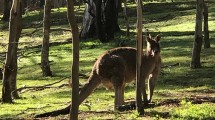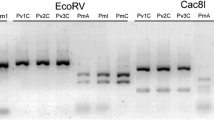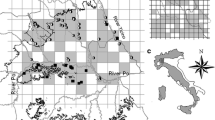Abstract
A non-invasive genetic approach has been recently employed in the population genetics of wild species, using faeces that could be easily collected, particularly of elusive or endangered species. However, faeces of pine (Martes martes) and beech marten (M. foina) can be morphologically similar and could be confused with those of polecat (Mustela putorius) and red fox (Vulpes vulpes). On this basis, a rapid, simple and inexpensive RFLP protocol using a cytochrome b (Cyt b) gene fragment of mtDNA, isolated from faecal samples, was performed to distinguish the above-mentioned species.


Similar content being viewed by others
References
Birks JDS, Messenger JE, Braithwaite AC et al (2004) Are scat survey a reliable method for assessing distribution and population status of pine marten? In: Martens and fishers (Martes) in human-altered environments: an international perspective. Springer Verlag, New York, pp 235–252
Bonin A, Bellemain E, Bronken Eidesen P et al (2004) How to track and assess genotyping errors in population genetic studies. Mol Ecol 13:3261–3273
Buchan JC, Archie EA, Van Horn RC et al (2005) Locus effects and sources of error in non-invasive genotyping. Mol Ecol Notes 5:680–683
Colli L, Cannas R, Deiana AM et al (2005) Identification of mustelids (Carnivora: Mustelidae) by mitochondrial DNA markers. Mamm Biol 70:384–389
Davison A, Birks JDS, Brooks RC et al (2002) On the origin of faeces: morphological versus molecular methods for surveying rare carnivores from their scats. J Zool 257:141–143
Kumar S, Tamura K, Nei M (2004) MEGA3: integrated software for molecular evolutionary genetics analysis and sequence alignment briefings. Bioinformatics 5:150–163
Kyle CJ, Davison A, Strobeck C (2003) Genetic structure of European pine martens (Martes martes), and evidence for introgression with M. americana in England. Conserv Genet 4:179–188
Lucentini L, Caporali S, Palomba A et al (2006a) A comparison of conservative DNA extraction methods from fins and scales of freshwater fish: a useful tool for conservation genetics. Conserv Genet DOI: 10.1007/s10592-006-9137-6
Lucentini L, Palomba A, Lancioni H, Natali M, Panara F (2006b) A non-destructive, rapid, reliable and inexpensive method to sample, store and extract high-quality DNA from fish body mucus and buccal cells. Mol Ecol Notes 6:257–260
Nagata J, Aramilev VV, Belozor A et al (2005) Fecal genetic analysis using PCR-RFLP of cytochrome b to identify sympatric carnivores, the tiger Panthera tigris and the leopard Panthera pardus, in far eastern Russia. Conserv Genet 6:863–866
Mitchell-Jones AJ, Amori G, Bogdanowicz W et al (1999) The Atlas of European mammals. T and AD Poyser Ltd, London
Riddle AE, Pilgrim KL, Mills LS et al (2003) Identification of mustelids using mitochondrial DNA and non-invasive sampling. Conserv Genet 4:241–243
Scandura M (2005) Individual sexing and genotyping from blood spots on the snow: a reliable source of DNA for non-invasive genetic surveys. Conserv Genet 6:871–874
Taberlet P, Waits LP, Luikart G (1999) Noninvasive genetic sampling: look before you leap. Trends Ecol Evol 14:323–327
Vercillo F, Lucentini L, Mucci N, Ragni B, Randi E, Panara F (2004) A simple and rapid PCR-RFLP method to distinguishing Martes martes and Martes foina. Conserv Genet 5:869–871
Acknowledgements
The authors are grateful to A. Vignati for critically reading the English manuscript. This work was partly supported by grants of University of Perugia and Regione dell’Umbria.
Author information
Authors and Affiliations
Corresponding author
Rights and permissions
About this article
Cite this article
Livia, L., Francesca, V., Antonella, P. et al. A PCR-RFLP method on faecal samples to distinguish Martes martes, Martes foina, Mustela putorius and Vulpes vulpes . Conserv Genet 8, 757–759 (2007). https://doi.org/10.1007/s10592-006-9203-0
Received:
Accepted:
Published:
Issue Date:
DOI: https://doi.org/10.1007/s10592-006-9203-0




